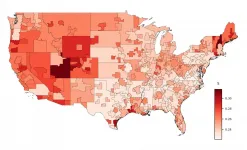(Press-News.org) Diversification in the sourcing of food into cities can go a long way to tempering "food shock" -- a sudden drop in food supply due to unforeseen events, according to a team of researchers from Penn State and Northern Arizona University, who developed a statistical risk model linking supply chain diversity to the probability of a city experiencing food shocks.
"The model is simple, operationally useful and hazard-agnostic," the researchers report today (July 8) in Nature. "Using this method cities can improve their resistance to food supply shocks with policies that increase the food supply chain diversity."
The researchers investigated four types of food -- crops, live animals, feed and meat -- over a four-year period from 2012 to 2015 when there were droughts and production shocks in the Great Plains and the western U.S.
"Cities fundamentally depend on other regions for the provision of food and other basic resources," said Alfonso Mejia, associate professor of civil and environmental engineering, Penn State. "We looked at food because it interconnects with other critical regional systems -- water and energy -- and food production is inherently linked to climate variability and change. We wanted to apply basic lessons from the natural world -- biodiverse ecosystems are more resistant to shocks, learned through millennia of adapting to disruption of all kinds -- to our human food systems."
Mejia notes that the main finding of their work was that they were able to find a distinct and predictable data-driven relationship between the diversity of the supply chain of cities and the possibility of the city having a food supply disruption. The researchers found that the higher the diversity of the supply chain, the lower the probability of that city experiencing a food shock.
"If a city's food sources are mainly from regions nearby, then its supply chain is not going to be very diverse," said Michael Gomez, doctoral candidate in civil engineering, Penn State. "It's not just distance though, there are other factors that impact diversity."
Some of the variables important to food shock resilience include location, climate, supply network characteristics and level of urbanization. If all a city's beef came from Texas during the drought, for example, then that city would have experienced a food shock with respect to beef during that time.
"There are a number of things that will have a ripple effect on the food supply chain," said Gomez. "Drought, heatwaves, flooding, cyberattacks, global pandemics."
Originally, the available food trade data covered 70 cities including New York and Los Angeles, but Gomez expanded their database to include information on all 284 designated metropolitan areas in the U.S., making their results more robust.
Cities can run into problems with supply chain diversity because they source products from few sources, from locations with similar climates, or from limited geographic areas, among other things, according to the researchers.
The researchers used a traditional engineering approach to look at cities' food supplies. They took the framework of risk analysis of 100-year floods and applied that to food shocks and diversity.
"The idea was to provide cities with an operational way for quantifying resilience and, ultimately, supporting action that can boost resilience through supply chain diversity," said Mejia. "In principle, with our approach, a city can figure out what their supply chain diversity is and what protection against food shock they have. If they decide there is not enough protection, then they can figure out, based in part on other cities' experience, how much diversity in the food chain they need to offer sufficient protection."
Food shocks can cause small variations in the price of food in the supermarket. According to Gomez, populations below the poverty line are the ones most impacted by these increases. However, he notes that designing policies that foster supply chain diversity is a major coordination challenge for cities and other actors involved in the food supply chain.
"But cities could also work together with government at different levels to increase resilience against food supply chain disruptions," said Mejia. "There are several U.S. government programs that relate to food -- the breakfast, lunch, afterschool and nutrition assistance programs. These programs may offer an untapped opportunity for diversifying supply chains and building resilience."
INFORMATION:
Others working on this project include Benjamin L. Ruddell, director and professor, School of Informatics, Computing, and Cyber Systems; and Richard R. Rushforth, assistant research professor of computing and cyber systems, both at Northern Arizona University.
The National Science Foundation supported this work. Additional data visualization for this research and the project that supported it is at fewsion.us/few-view-3/.
A massive explosion from a previously unknown source - 10 times more energetic than a supernova - could be the answer to a 13-billion-year-old Milky Way mystery.
Astronomers led by David Yong, Gary Da Costa and Chiaki Kobayashi from Australia's ARC Centre of Excellence in All Sky Astrophysics in 3 Dimensions (ASTRO 3D) based at the Australian National University (ANU) have potentially discovered the first evidence of the destruction of a collapsed rapidly spinning star - a phenomenon they describe as a "magneto-rotational hypernova".
The previously unknown type of cataclysm - which occurred barely a billion years after the Big Bang - is the most likely explanation ...
Our cells fight microbial invaders by engulfing them into membrane sacs - hostile environments in which pathogens are rapidly destroyed. However, the pathogen Salmonella enterica, which grows and reproduces inside our cells, has evolved ways to detoxify such hostile compartments, turning them into a comfortable home where Salmonella can survive and thrive.
A team of scientists led by EMBL group leader Nassos Typas has uncovered new details of Salmonella´s survival strategies. The researchers analysed protein interactions in Salmonella-infected cells to identify the diverse biological processes of the host cell that the bacterium uses. Salmonella targets and modifies cellular protein machineries and pathways, ...
Scientists from Trinity College Dublin are homing in on a recipe that would enable the future production of entirely renewable, clean energy from which water would be the only waste product.
Using their expertise in chemistry, theoretical physics and artificial intelligence, the team is now fine-tuning the recipe with the genuine belief that the seemingly impossible will one day be reality.
Initial work in this area, reported just under two years ago, yielded promise. That promise has now been amplified significantly in the exciting work just published in leading journal, Cell Reports Physical Science.
Energy ...
Researchers from North Carolina State University have developed a patch that plants can "wear" to monitor continuously for plant diseases or other stresses, such as crop damage or extreme heat.
"We've created a wearable sensor that monitors plant stress and disease in a noninvasive way by measuring the volatile organic compounds (VOCs) emitted by plants," says Qingshan Wei, co-corresponding author of a paper on the work. Wei is an assistant professor of chemical and biomolecular engineering at NC State.
Current methods of testing for plant stress or disease involve taking plant tissue samples and conducting an assay in a lab. However, this ...
The Hikurangi Margin, located off the east coast of the North Island of New Zealand, is where the Pacific tectonic plate dives underneath the Australian tectonic plate, in what scientists call a subduction zone. This interface of tectonic plates is partly responsible for the more than 15,000 earthquakes the region experiences each year. Most are too small to be noticed, but between 150 and 200 are large enough to be felt. Geological evidence suggests that large earthquakes happened in the southern part of the margin before human record-keeping began.
Geophysicists, geologists, and geochemists from throughout the world have been working together to understand why this plate boundary behaves as it does, producing both imperceptible silent earthquakes, but also potentially major ...
Reston, VA--For patients with pancreatic ductal adenocarcinomas (PDAC), molecular imaging can improve staging and clinical management of the disease, according to research published in the June issue of The Journal of Nuclear Medicine. In a retrospective study of PDAC patients, the addition of PET/CT imaging with 68Ga-FAPI led to restaging of disease in more than half of the patients, most notably in those with local recurrence.
PDAC is a highly lethal cancer, with a five-year survival rate of less than 10 percent. Optimal imaging of PDAC is crucial for accurate initial TNM (tumor, node, metastases) staging and selection ...
Dancing with music can halt most debilitating symptoms of Parkinson's disease
First-of-its-kind York U study shows participating in weekly dance training improves daily living and motor function for those with mild-to-moderate Parkinson's
TORONTO, July 7, 2021 - A new study published in Brain Sciences today, shows patients with mild-to-moderate Parkinson's disease (PD) can slow the progress of the disease by participating in dance training with music for one-and-a-quarter hours per week. Over the course of three years, this activity was found to reduce daily motor issues such as those related to balance and speech, ...
When a head of state or government official travels to another country to meet with his/her counterpart, the high-level visit often entails a range of public diplomacy activities, which aim to increase public support in the host country. These activities often include events such as hosting a joint press conference, attending a reception or dinner, visiting a historic site, or attending a social or sports event. A new study finds that public diplomacy accompanying a high-level visit by a national leader increases public approval in the host country. The findings are published in the American Political ...
The Arctic is warming at approximately twice the global rate. A new study led by researchers from McGill University finds that cold-adapted Arctic species, like the thick-billed murre, are especially vulnerable to heat stress caused by climate change.
"We discovered that murres have the lowest cooling efficiency ever reported in birds, which means they have an extremely poor ability to dissipate or lose heat," says lead author Emily Choy, a Postdoctoral Fellow in the Natural Resource Sciences Department at McGill University.
Following reports of the seabirds dying in their nests on sunny days, the researchers trekked the cliffs ...
Data from nine cities in Mexico confirms that identifying dengue fever “hot spots” can provide a predictive map for future outbreaks of Zika and chikungunya. All three of these viral diseases are spread by the Aedes aegypti mosquito. Lancet Planetary Health published the research, led by Gonzalo Vazquez-Prokopec, associate professor in Emory University’s Department of Environmental Sciences. The study provides a risk-stratification method to more effectively guide the control of diseases spread by Aedes aegypti. “Our results can help public health officials to do targeted, proactive interventions ...






